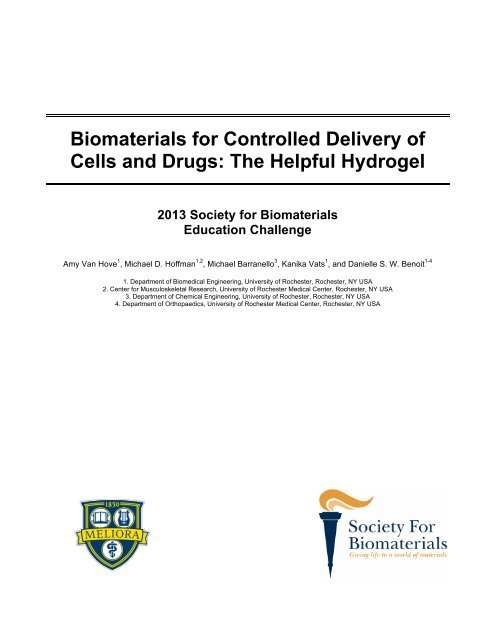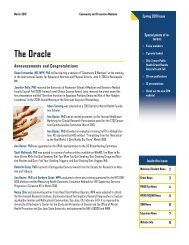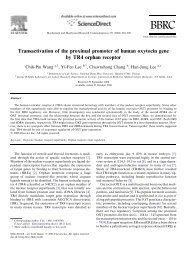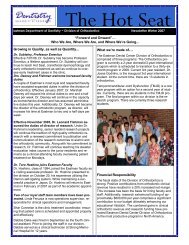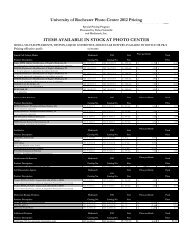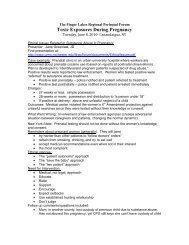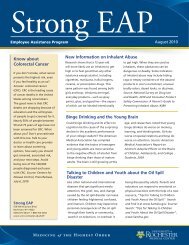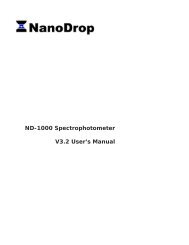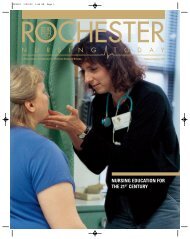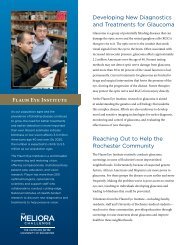SFB Education Challenge - UR_2013 - University of Rochester ...
SFB Education Challenge - UR_2013 - University of Rochester ...
SFB Education Challenge - UR_2013 - University of Rochester ...
Create successful ePaper yourself
Turn your PDF publications into a flip-book with our unique Google optimized e-Paper software.
• Setup cost: $20-80• Recurring cost: $20Teaching Resources Provided:• Summary <strong>of</strong> scientific background• References to relevant literature for additional background knowledge• Required materials, suggested sources, and cost estimates• Cost-saving alternative methods• Detailed instructions for module preparation and setup• Detailed script for classroom activities• Clearly defined learning objectives• List <strong>of</strong> relevant scientific vocabulary• Suggestions for advanced modifications to further enhance student comprehension and involvement• Post-module assessment worksheet and keySociety for Biomaterials <strong>Education</strong> <strong>Challenge</strong> 6!
Background Material:Hydrogels are hydrophilic polymer networks that absorb water within their crosslinked mesh. Hydrogelscan be either natural (i.e. agarose, hyaluronan) or synthetic (i.e. poly(ethylene glycol)) and are widely usedas biomaterials that improve, mimic, or replace important components <strong>of</strong> the human body. For example,contact lenses are hydrogel networks (usually polyacrylamides) engineered to correct vision. One <strong>of</strong> themost promising areas <strong>of</strong> biomaterial development is the use <strong>of</strong> hydrogels as scaffolds for tissueengineering (1). The emergence <strong>of</strong> hydrogels in tissue engineering applications has been driven by anoverwhelming (and increasing) number <strong>of</strong> patients that require organ therapy (treatment, removal,transplantation). Synthetic hydrogels are particularly attractive for tissue engineering applications becausethey have tunable physical, biological, and mass transport properties (1).For tissue engineering applications, physical properties are <strong>of</strong> great importance because they dictate themechanical interaction <strong>of</strong> the implanted biomaterial (hydrogel) with the surrounding cells, matrix, and tissue(bone, cartilage, tendon, neurons). Matching mechanical properties <strong>of</strong> the hydrogels to the surroundinghost tissue is important and can prevent shear degradation (or fracture) <strong>of</strong> the implanted hydrogel or hosttissue. Hydrogels can be tailored to possess a specific stiffness, toughness, and/or elasticity by altering thechemical composition <strong>of</strong> the network, the type <strong>of</strong> crosslinker used, the reaction time, and the weight percent<strong>of</strong> monomer in the hydrogel precursor solution. The hydrogel network is formed when macromer chainends are activated (usually with an initiator) and allowed to bond with a crosslinking agent to produce aninterconnected scaffold with a characteristic “mesh size.” For a given hydrogel composition, the mesh size(distance between crosslinks) controls the physical strength (stiffness) and degree <strong>of</strong> water infiltration(swelling <strong>of</strong> hydrogel). The Flory-Rehner equation allows for calculation <strong>of</strong> hydrogel mesh size based onsome known properties <strong>of</strong> the polymer network, such as the degree <strong>of</strong> swelling (2).Importantly, a multitude <strong>of</strong> other components can be included in the hydrogel precursor solution that, uponpolymerization, will be present within the hydrogel mesh. These components include (but are not limited to)proteins, growth factors, cytokines, chemokines, and living cells. Therefore, hydrogel scaffolds (alreadycontaining living cells and growth factors) can be implanted to supplement the cell and tissue resources atthe site <strong>of</strong> injury to aid in healing. Furthermore, the cytocompatible (non-toxic to cells) nature <strong>of</strong> thehydrogel polymerization allows for formation <strong>of</strong> the therapeutic scaffold within the body at the point <strong>of</strong>interest (surrounding a fractured bone, around a severed neuron, within a damaged heart, etc.).The ability to easily tune the physical properties <strong>of</strong> hydrogels allows further control over the cellularmicroenvironment because mechanical properties <strong>of</strong> crosslinked networks greatly impact cell fate andbehavior. While most cell types will survive the polymerization and encapsulation process, stem cells areparticularly useful because they can be driven down specific lineages to generate specific tissues requiredfor healing (i.e. bone, muscle, cartilage). Stem cells are immature, multipotent cells capable <strong>of</strong> undergoingproliferation, self-renewal, and differentiation (3). Interestingly, stem cells, seeded on the surface <strong>of</strong> orencapsulated within hydrogels <strong>of</strong> different stiffness will differentiate into specific lineages as a result <strong>of</strong> theirmechanical interaction with their surrounding environment! (3). For example, Engler et al. showeddifferentiation <strong>of</strong> stem cells down neurogenic (brain), myogenic (muscle), and osteogenic (bone) lineagesas hydrogel stiffness increased. In addition to controlling the genetic expression <strong>of</strong> stem cells, the physicalenvironment provided by the hydrogel scaffold can also modulate stem cell motility (movement) andphenotype (physical appearance) (3). Control over stem cell fate can be <strong>of</strong> great use in tissue engineeringbecause it allows implantation <strong>of</strong> general multipotent cells (stem cells) that can reliably differentiate intomature, functional cells <strong>of</strong> a desired lineage.!Similarly, the physical properties <strong>of</strong> the hydrogel also greatly affect its mass transport properties. Aspreviously described, hydrogels can be synthesized to encapsulate proteins, growth factors, cells, andtherapeutic agents (drugs). The release kinetics <strong>of</strong> this cargo at the implanted site is very important fortherapeutic applications; therefore it is essential to have the ability to adjust the rate <strong>of</strong> nutrient (or drug,cell, protein) transport for different applications. The governing equation for mass transport is given below(Eq. 1) in differential form (also known as Fick’s Law). In Equation 1, J is the molar diffusive flux (theamount <strong>of</strong> drug transported per area per unit time, mol/(m 2 s)), D is the diffusion coefficient (m 2 /s), and Cis the molar concentration gradient (mol/m 3 m).Society for Biomaterials <strong>Education</strong> <strong>Challenge</strong> 7!
From Equation 1, it is apparent that the greatest molar diffusive flux (fastest mass transport) will occur for amolecule with both a large diffusion coefficient and molar concentration gradient. The diffusion coefficientis a property <strong>of</strong> the molecule (i.e. drug, protein, etc.), the media it is dispersed in (i.e. water), and thetemperature (higher temperature = higher diffusion coefficient). The concentration gradient is the drivingforce behind diffusion-mediated transport. Molecules in a high, localized concentration will undergo masstransport until the concentration is equal throughout the entire volume (mass is transported from areas <strong>of</strong>high concentration to areas <strong>of</strong> low concentration).For a given application, the variables in Equation 1 will be equivalent, meaning that modulation <strong>of</strong> masstransport and ultimately release <strong>of</strong> encapsulated molecules will be dependent on the physical properties <strong>of</strong>the hydrogel (primarily mesh size). A larger hydrogel mesh size will result in faster molecular release fromthe hydrogel because there is more room for water infiltration (swelling), and the molecular path <strong>of</strong> theencapsulated drug is less tortuous (more room for the molecular to diffuse out <strong>of</strong> the hydrogel). Diffusion <strong>of</strong>encapsulated materials to the surrounding media will take on a different “effective diffusivity” depending onthe mesh size <strong>of</strong> the hydrogel. Because mesh size can modulate release based on size, hydrogels can beengineered to possess “sieve” characteristics to release smaller molecules more rapidly and largermolecules more gradually. Similarly, the mesh size <strong>of</strong> a hydrogel can be altered to control how quickly asingle type <strong>of</strong> drug molecule is released (big mesh size = faster, small mesh size = slower). This conceptcan also be applied to dual delivery <strong>of</strong> drugs (or growth factors) and subsequent release <strong>of</strong> cells.The versatility and tunability <strong>of</strong> hydrogel properties makes them a uniquely attractive platform for many totissue engineering applications. While mechanical, biological, and mass transport properties <strong>of</strong> hydrogelsare interdependent, they can also be individually tailored to satisfy the constraints <strong>of</strong> more complicatedapplications. The use <strong>of</strong> hydrogel scaffolds has the potential to match mechanical properties to theimplantation site, direct stem cell differentiation towards target cell lineages, and modulate delivery <strong>of</strong>additional factors (drugs, proteins, nutrients) in a controlled manner.REFERENCES:1. J. L. Drury, D. J. Mooney, Biomaterials 24, 4337 (Nov, 2003).2. S. P. Zustiak, J. B. Leach, Biomacromolecules 11, 1348 (May 10, 2010).3. Kshitiz et al., Integr Biol-Uk 4, 1008 (2012).Society for Biomaterials <strong>Education</strong> <strong>Challenge</strong> 8!
!Demo #1: How Stiff am I?During this demonstration students will investigate how hydrogel biomaterials can be altered to change theirstiffness and thereby simulate the different tissues <strong>of</strong> the body. Furthermore, students will learn how differenthydrogel stiffness can be used to control stem cell function and development. By conducting a series <strong>of</strong> thoughtexperiments in combination with hands on tactile learning, students will gain an understanding <strong>of</strong> how hydrogelscan be used to therapeutically deliver stem cells in regenerative medicine applications.Materials- Jell-O ® (3) (Boxed Jell-O ® Brand – three distinct colors like blue, green, and orange)- Tap water- Measuring cup- Mixing Bowls (3)- Ice cube trays (3)- Re-sealable Tupperware Container (3)- Microwave / RefrigeratorMethodsPreparation <strong>of</strong> “Normal” Jell-O ® – this must be done 24hrs before lesson so that Jell-O ® can set1. Microwave 1 cup <strong>of</strong> tap water until hot2. Add water to a mixing bowl and stir in 1 box <strong>of</strong> Jell-O ® powder until fully dissolved3. Once fully dissolved add 1 cup <strong>of</strong> cold tap water4. Pour Jell-O ® mixture into ice cube tray (will probably have extra mix that can be discarded)5. Place ice cube tray into the refrigerator and allow to set overnight6. Once Jell-O ® has set overnight carefully remove each “cube” from the tray and place all “cubes” into asingle re-sealable Tupperware containerPreparation <strong>of</strong> “S<strong>of</strong>t” Jell-O ® – this must be done 24hrs before lesson so that Jell-O ® can set1. Microwave 2 cups <strong>of</strong> tap water until hot2. Add water to a mixing bowl and stir in 1 box <strong>of</strong> Jell-O ® powder until fully dissolved3. Once fully dissolved add 2 cups <strong>of</strong> cold tap water4. Pour Jell-O ® mixture into ice cube tray (will probably have extra mix that can be discarded)5. Place ice cube tray into the refrigerator and allow to set overnight6. Once Jell-O ® has set overnight carefully remove each “cube” from the tray and place all “cubes” into asingle re-sealable Tupperware container (Jell-O ® will be very s<strong>of</strong>t, handle with care)Preparation <strong>of</strong> “Stiff” Jell-O ® – this must be done 24hrs before lesson so that Jell-O ® can set1. Microwave 3/4 cup <strong>of</strong> tap water until hot2. Add water to mixing bowl and stir in 1 box <strong>of</strong> Jell-O ® powder until fully dissolved3. Pour Jell-O ® mixture into ice cube tray (will probably have extra mix that can be discarded)4. Place ice cube tray into the refrigerator and allow to set overnight5. Once Jell-O ® has set overnight carefully remove each “cube” from the tray and place all “cubes” into asingle re-sealable Tupperware container*These “hydrogels” have a stiffness that resembles fat (s<strong>of</strong>t Jell-O ®) cartilage (normal Jell-O ®), and bone(stiff Jell-O ®) so we encourage teachers to obtain some scraps (fat, cartilage, and bone) can be obtainedfrom a local grocery store to allow students to do a direct comparison (touching them with gloves on)**Also because <strong>of</strong> their different stiffness, if we were to encapsulate stem cells into these three differenthydrogels the cells would grow up to become fat cells, a.k.a adipocytes (s<strong>of</strong>t Jell-O ®) cartilage cells, a.k.a.chondrocytes (normal Jell-O ®), and bone cells, a.k.a osteoblasts (stiff Jell-O ®) (see attached literature)Society for Biomaterials <strong>Education</strong> <strong>Challenge</strong>9!
Demo #3: Diffusivity Calculation (OPTIONAL)During this activity students will have the opportunity to analyze their data like real scientist, turning pictures intonumbers. Students will use a free analysis program (ImageJ) made available by the National Institute <strong>of</strong> Health(NIH) to calculate the area <strong>of</strong> food coloring diffusion for each gelatin mold at each time point observed (2, 5, and10 min). Students will then plot a line <strong>of</strong> time (x-axis) versus diffusion area (y-axis) for each <strong>of</strong> the gelatin molds.By calculating the slope <strong>of</strong> each line students will determine the diffusivity (units cm 2 /s) <strong>of</strong> food coloring in each<strong>of</strong> the gelatin molds and relate it back to the hydrogel composition.Materials- Digital camera- Computer- ImageJ s<strong>of</strong>tware (Free to download from: http://rsb.info.nih.gov/ij/)- Micros<strong>of</strong>t excel- Images <strong>of</strong> food coloring and gelatin molds (from Demo #2)- Quarter (25 cents)Methods!1. Download and install ImageJ on computer2. Upload gelatin + food coloring images to computer3. Open ImageJ ! select “File” ! “Open” ! select image from the computer4. Once image is open select the “Polygon Selections” tool from the ImageJ tool bar5. Click on the edge <strong>of</strong> food coloring diffusion area to select the first point and then slowly trace the entireouter edge <strong>of</strong> the food coloring diffusion area by selecting additional point all the way around.a. The program will automatically close the loop when you get close enough!!!!!!!!!!!!!!!!!!!!!! …outlining diffusion area…! !6. Once area is outlined select “Analyze” ! “Set Measurement”a. Select “Area” and unselect everything else7. Select “Analyze” ! “Measure”a. Window will pop-up with area measurement (units are in pixles)8. Record measurement (Micros<strong>of</strong>t excel) and repeat steps 3-7 for all images9. Measure area <strong>of</strong> a quarter (image <strong>of</strong> a quarter) using ImageJa. The area <strong>of</strong> quarters face is 4.6 cm 2 – this can be used to convert pixel area to cm 210. Using Micros<strong>of</strong>t Excel create a line plot <strong>of</strong> Time (seconds; x-axis) versus Diffusion Area (cm 2 ; y-axis)11. Determine slope <strong>of</strong> each line which will give diffusivity (units cm 2 /s)a. Select “Add Trendline” ! “Options” ! “Display Equation on Chart”Society for Biomaterials <strong>Education</strong> <strong>Challenge</strong> 11!
Script for “Biomaterials for controlled delivery <strong>of</strong> cells and drugs: the helpful hydrogel”Demo # 1: How Stiff am I?Modifying Hydrogel Properties for Tissue Engineering & Stem Cell Delivery.Jell-O is used to help students understand what biomaterials are, how biomaterials are designed to (a) bettermatch the stiffness <strong>of</strong> real tissues in the body, and (b) control stem cell behavior in regenerative medicalapplications. This script is intended to be read by the educator, either read as-is to the class in conductingthe demonstration, or used as a guideline in preparing the lesson plan. Action statements are indicated initalics. Start reading the script after the “introduction”. For additional depth, teachers can ask students tocreate tables <strong>of</strong> their observations in their notebooks, in addition to discussing their observations as a group.For the above-mentioned demonstration in class, you will need1. “Normal” Jell-O (see Materials & Methods, Demo # 1) (Prepare in advance)2. “S<strong>of</strong>t” Jell-O (see Materials & Methods, Demo # 1) (Prepare in advance)3. “Stiff “ Jell-O (see Materials & Methods, Demo # 1) (Prepare in advance)4. Chicken (separated into fat, muscle, and bone) (Buy and prepare in advance. Bone and fat cancommonly be obtained for free from a butcher)5. Gloves6. Paper towelsIntroduction (Script Starts)Today, we are going to be learning about biomaterials. A biomaterial is any material that interacts with thebody to repair, change, or replace the bodies’ function. So this could be something complicated like a hipreplacement, that is used to replace a hip joint after its been damaged, or something simple like a band-aid,that helps your body heal scrapes better by protecting them and keeping them clean. Can you think <strong>of</strong> anyother biomaterials?(Students brainstorm- other examples include contact lenses, artificial heart valves, stitches, dentures…)How stiff am I? Understanding differences between different tissuesFirst, we are going to explore how stiff different tissues in the body are. A tissue is a structure in the bodymade <strong>of</strong> similar cells that work together to do a specific job. We are going to look at fat, muscle, and bonefrom chicken. Fat is made up <strong>of</strong> large, round fat cells, and helps keep the body warm and cushions yourinternal organs when you jump, run, or fall. Muscle is made up <strong>of</strong> long, stretchy muscle cells, that contract(squeeze together) to pull on your bones and make you move. If you flex your arm, while feeling your bicep,you can feel how the muscle in your arm squeezes together to make your arm move.(Demonstrate arm flexing and feeling the muscle contract).Bone is the ridged, hard part <strong>of</strong> your body that give you your shape and hold you up. Some <strong>of</strong> them, like yourribs, help keep your s<strong>of</strong>ter organs (like your stomach) from getting hurt when you fall. Bones are made up <strong>of</strong>a lot <strong>of</strong> types cells, minerals, and other components that work together to give.Distribute gloves to all the students in the class and ask them to wear gloves. At this time distribute scraps <strong>of</strong>chicken fat, muscle and bone on a paper towel.What you now see in front <strong>of</strong> you is a fat tissue. Using your hands, press a small portion <strong>of</strong> the tissue andfeel its stiffness.This is muscle tissue. Using your hands, press a small portion <strong>of</strong> the tissue and feel its stiffness. Note thedifferences between the two tissue types.Lastly, we have bone. Using your hands, press a small portion <strong>of</strong> bone and feel its stiffness. Which one <strong>of</strong>the three tissues you just saw is the hardest and which one is the s<strong>of</strong>test?Society for Biomaterials <strong>Education</strong> <strong>Challenge</strong> 12!
Forming a HydrogelNow we will investigate how hydrogels can be used to mimic tissues <strong>of</strong> different stiffnesses.Who has ever made Jell-O before?”Let them raise their handsWell, in order to make Jell-O we add hot water to the powder mix. The powder is gelatin- it is a kind <strong>of</strong>polymer, the string <strong>of</strong> beads that tie together to make a crosslinked mesh network. The gelatin in Jell-O getstied together using heat energy from the water to form the Jell-O hydrogel. We are going to do a hands-onexperiment using Jell-O to better understand how we can modify hydrogel structure to control hydrogelproperties.To do this everyone is going to need to put on gloves. Remember, SAFETY FIRST!Hand out paper towels, and 3 different kinds <strong>of</strong> hydrogels (s<strong>of</strong>t, stiff, and normal Jell-O)As we hand out these hydrogel samples, don't touch them but take a moment and make some observationsabout how they look. Other than being different colors, how do these hydrogels differ from each other?(Let the students voice their observations)Now everyone, take the paper towel and wiggle the Jell-O around on the table a little bit – How do thehydrogels behave differently? Ok, now here is a question for everyone – Which hydrogel feels like a liquid,and which hydrogel feels like a solid?(Let students squish the gels with their hands)If we could take a close up look at the structure <strong>of</strong> these gels which one do you think would look likethis…(draw on board)… and which one do you think would look like this? (draw on board)Does that make sense based on what we said about which one was more like a solid and which one wasmore like a liquid? Increasing the amount <strong>of</strong> polymer in the hydrogel increases the number <strong>of</strong> crosslinks,Society for Biomaterials <strong>Education</strong> <strong>Challenge</strong> 14!
which makes the gel behave more like a solid. That is exactly how we made three different stiffnesses <strong>of</strong>hydrogel using the same Jell-O material- the s<strong>of</strong>ter ones have a lot more water in them than the stiff one.We said that the more water there was in the hydrogel, the more fluid-like and s<strong>of</strong>t it was. This is because <strong>of</strong>the larger mesh size (!) within the hydrogel network. Mesh size is the size <strong>of</strong> the holes inside the hydrogelnetwork. The larger the mesh size, the more water is filling the hydrogel, and the s<strong>of</strong>ter and more water-likethe hydrogel will be.(Draw the figure below)The larger the mesh size is, the s<strong>of</strong>ter the hydrogel. We can make the mesh size <strong>of</strong> the hydrogel larger byeither using longer polymers, so there is more space between the crosslinks, or using less polymer (Jell-O)to make the hydrogel, to increase the space between crosslinks. The amount <strong>of</strong> polymer used can bemeasured in terms <strong>of</strong> “weight percent”- that means, by weight, how much <strong>of</strong> the hydrogel is made up <strong>of</strong> thepolymer. Higher weight percent polymer means there is more <strong>of</strong> the Jell-O in the hydrogel, and it will bestiffer. Lower weight percent polymer means there is less Jell-O and more water in the hydrogel, and it willbe s<strong>of</strong>ter.We can calculate what weight percent <strong>of</strong> the hydrogel is gelatin by dividing the weight that is gelatin by thetotal weight <strong>of</strong> the gel. For example, our s<strong>of</strong>test gels were made by combining 3 ounces <strong>of</strong> gelatin with 32ounces <strong>of</strong> water (4 cups).(do math on board)So s<strong>of</strong>test hydrogel is made up <strong>of</strong> 3/(3+32)*100%=8.5% gelatin. Our stiffest gels were made by combining 3ounces <strong>of</strong> gelatin with 6 ounces water (3/4 cups). So the stiffest hydrogel is made up <strong>of</strong> 3/(3+6)*100=33%gelatin.Matching Tissue and Biomaterial StiffnessesWhen designing a biomaterial, it is important that the material matches the stiffness <strong>of</strong> the tissue. If thematerial is too hard, it can damage the surrounding tissue and cause more harm than good. But if thematerial is too s<strong>of</strong>t, the surrounding tissue can damage it, and destroy the material before it can do its job! Ifyou were designing a replacement for bone, say for after someone had to have part <strong>of</strong> their bone removedbecause <strong>of</strong> cancer, which <strong>of</strong> the Jell-O hydrogels would you use?(wait for student discussion- stiffest gels)What kinds <strong>of</strong> tissues could you use the other two types <strong>of</strong> hydrogel to replace?(wait for student discussion- muscle for the middle, and fat or brain/neural tissue for the s<strong>of</strong>test)Society for Biomaterials <strong>Education</strong> <strong>Challenge</strong> 15!
Thought Experiment – if you were a cell in a hydrogelSo let’s talk a little more about how hydrogels can be used in biomedical engineering approaches to delivercells and help healing. How many people have heard <strong>of</strong> the special kind <strong>of</strong> cells called Stem Cells?(Wait for students to answer)Does anyone know what makes Stem Cells special?Stem Cells are special because they can grow up to become any type <strong>of</strong> cell in your body! Stem cells canboth replace itself and become many kinds <strong>of</strong> more mature, grown-up cells. When a stem cell replaces itself,it is called “self-renewal”- they are renewing themselves. They can be found in many tissues within the body,including your bone marrow and fat. When stem cells become a more mature type <strong>of</strong> cell, it is calleddifferentiation. Think about this word- differentiation: it starts with different (stem cells are becomingsomething different, a more mature type <strong>of</strong> cell) and ends with ation- which means action. So when cellsdifferentiate, they are becoming a different type <strong>of</strong> cell. This is one <strong>of</strong> the ways your body replaces cells whenthey become old or damaged.When stem cells become neural cells (from the brain or spinal cord), it is called neurogenic differentiation.When they become the cells <strong>of</strong> the bone, it is called osteogenic differentiation. And when they becomemuscle cells, it’s called myogenic differentiation.And cooler, Stem Cells can sense their environment and grow up to become a cell specific to that area <strong>of</strong> thebodySometimes, the body’s own stem cells are not able to fully heal and repair it after damage. Hydrogels can beused to deliver Stem Cells within the body to help with this healing and repair. This is called Regenerativemedicine, which focuses on the use <strong>of</strong> stem cells to repair the body after it becomes damaged, or to replaceor help support part <strong>of</strong> the body if it can’t perform its job well enough. Regenerative medicine is a sub-group<strong>of</strong> tissue engineering, and also involves the use <strong>of</strong> drugs to help repair or replace a biological function, so itisn’t restricted to only the use <strong>of</strong> stem cells.If you were a Stem Cell and we put you in the s<strong>of</strong>test hydrogel what might you grow up to become? Whattypes <strong>of</strong> tissue in the body are really s<strong>of</strong>t?(wait for guesses)Maybe cartilage in your knee, or fat or brain tissue?What if we put you in the hardest hydrogel? What kind <strong>of</strong> tissue might you grow up to become?(wait for guesses)What types <strong>of</strong> tissue in the body are really hard? – maybe bone?(wait for guesses)Finally, what about the medium gel? Muscle?Just by changing the stiffness <strong>of</strong> the hydrogels we can control what kinds <strong>of</strong> tissues Stem Cells can become.Collect gloves and hydrogels and throw them in the garbageSummaryIn summary we have learned that:• Tissues have varying material properties (stiffnesses) based on their function• Matching biomaterial and host tissue properties is a critical design consideration• Hydrogels are highly crosslinked, hydrophilic networksSociety for Biomaterials <strong>Education</strong> <strong>Challenge</strong> 16!
• Hydrogel mesh size and stiffness can be controlled by varying the gel composition• Stem cells are an exciting, versatile cell type that can be used for a variety <strong>of</strong> therapeuticapplications• Stem cell behavior (differentiation) can be controlled by altering biomaterial properties• Biomaterials such as hydrogels can be used to deliver stem cells for therapeutic applicationsSociety for Biomaterials <strong>Education</strong> <strong>Challenge</strong> 17!
Demo # 2: How Quick am I?Modifying Hydrogel Properties for Controlled Drug DeliveryBy modifying the weight percentage <strong>of</strong> clear gelatin used to produce hydrogels, hydrogel mesh size will bevaried. Students will then add a model drug to the center <strong>of</strong> the hydrogel, and investigate the differences indrug diffusion as a result <strong>of</strong> the differences in mesh size. Students will draw connections between the gelproperties and rate <strong>of</strong> drug release, and will apply their knowledge as they identify therapeutic applicationsfor each hydrogel network. If students do not have class notebooks to record their observations in, extrapaper should be provided for data collection.For the above-mentioned demonstration in class, you will need following:1. 1:5 gelatin molds, 1:10 gelatin molds, 1:50 gelatin molds, and water only (at room temperature) (seeMaterials and Methods, prepare in advance)2. Food coloring3. Digital camera (Optional)4. Stopwatch5. Computer (Optional)6. ImageJ s<strong>of</strong>tware (Optional)7. Excel s<strong>of</strong>tware (Optional)8. Plain white paperIntroductionInstead <strong>of</strong> putting Stem Cells in these hydrogels, what if we were to put medicine inside each <strong>of</strong> these gels?(point to the large and small mesh size drawings on the board, add in circular “drug molecules”)If we put drugs in these hydrogels, they would become a drug delivery system. “Drug delivery” involvesengineering systems to help with the delivery <strong>of</strong> a pharmaceutical agent, a drug, to a person or animal, toachieve a therapeutic effect. That “therapeutic effect” could be something like reducing pain, or speeding uphealing. Drug delivery systems help get drugs where they’re needed, at the levels they are needed. Theyhelp reduce unwanted side effects by keeping drugs located only where they are needed.Which one would let the medicine out first? The bigger one! Because it has more room inside <strong>of</strong> it for thedrug to move around and escape! On the other hand the tighter gel would let the medicine out more slowly.The release <strong>of</strong> the drug from these hydrogel networks is controlled by diffusion, which is the process bywhich atoms travel in a random path through a solution, eventually reaching an even distribution throughoutthe entire solution volume. Diffusion happens based on random motion <strong>of</strong> the atoms, and does not require anexternal force such as mixing.Society for Biomaterials <strong>Education</strong> <strong>Challenge</strong> 18!
We have all heard the ads for painkillers that make your headache go away fast and keep it away all day –well this is how it works – part <strong>of</strong> it is fast acting (point to large mesh size drawing) and part <strong>of</strong> it is long acting(point to small mesh size drawing.Now we move on to our next demo where we will understand how using gelatin at different concentrationslets us control the rate at which drugs are released in different tissue environment.Diffusion <strong>of</strong> dye in gelatin hydrogelsThis demo can be done in groups <strong>of</strong> 5-6 studentsI am going to give your group three types <strong>of</strong> gelatin hydrogels, labeled 1:5, 1:10, and 1:50 which have beenprepared by changing the weight% <strong>of</strong> gelatin. You will also have a dish containing only water. Place them ontop <strong>of</strong> a white paper, and label the paper with your initials and what each mold has in it.Distribute the four dishes (containing 1:5, 1:10, and 1:50 gelatin, and plain water) to each group. Wait forstudents to label their papers. Give students extra paper to record their observations on if they don’t haveclass notebooks they are using to record the data.Let me explain the difference between 1:5, 1:10 and 1:50 gelatin hydrogel. In 1:5, we have 1 part gelatin to 5parts tap water. Similarly, 1:10 gelatin molds has 1 part gelatin and 10 parts tap water and so on. Therefore1:5 is the hardest because it has the highest weight percentage that is gelatin, while 1:50 is the s<strong>of</strong>test,because it has the highest weight percentage water. Based on what we just learned about weight percentand mesh size, which do you think would have the largest mesh size, and which would have the smallest?Wait for students to guess about the differences in mesh size.Right! The gels with the higher weight percentage gelatin will have smaller mesh sizes, which is why they arestiffer. These differences in mesh size also cause them to have different diffusivity, which is what we’re goingto be investigating next.You are going to write down your observation at (A) immediately when the drop is added, (b) 2 min after, (c)5 min after, (d) 10 min after. If possible take pictures, or measure and record the diameter <strong>of</strong> the area the dyecovers, at these time points.Have each group place a drop <strong>of</strong> blue food coloring at the center <strong>of</strong> each mold and start the timer.Wait for at least 15 minutes to let the students make their observationsSociety for Biomaterials <strong>Education</strong> <strong>Challenge</strong> 19!
What are the differences between the three molds with respect to diffusion <strong>of</strong> food coloring? Which moldshowed the fastest diffusion? Which had the slowest?Encourage students to voice their observations.Stiff gels (1:5 gelatin molds) allow slowest diffusion <strong>of</strong> dye while s<strong>of</strong>test gelatin gels (1:50) allows most dyediffusion. The water mold showed the most rapid mixing <strong>of</strong> the dye.Thus using this simple experiment we learnt that by changing the properties <strong>of</strong> gels we can control how fastor slow dye molecules travel (diffuse) into the neighboring tissues. This is one way that we can control therelease <strong>of</strong> drugs from a hydrogel network- if we put a drug in the 1:5 gelatin hydrogel, it will release the drugmuch more slowly than the 1:50 gelatin hydrogel would.Collect molds and trash themSummaryIn summary we have learned that:• Biomaterials like hydrogels can be used to deliver drugs• Diffusion is the process where molecules move from areas <strong>of</strong> high to low concentration• Hydrogel mesh size can be used to control the rate <strong>of</strong> drug diffusion within the hydrogel• Material properties such as mesh size can be altered to control drug release for therapeuticapplications• Collection and graphical representation <strong>of</strong> data can provide useful insight to the biomaterial systembeing investigatedSociety for Biomaterials <strong>Education</strong> <strong>Challenge</strong> 20!
Post-Lesson Worksheet1 If you formed a hydrogel by combining 15 g <strong>of</strong> gelatin and 45 g <strong>of</strong> water, what weightpercentage (wt%) <strong>of</strong> the gel would be gelatin? Show your work.2 If you wanted to make a hydrogel that was 7 wt% gelatin, and wanted the total weight <strong>of</strong>the hydrogel to be 50 g, how much water and gelatin would you combine? Show yourwork.3 Why is it important to match the stiffness <strong>of</strong> a biomaterial to the stiffness <strong>of</strong> the tissue itwill be used in?________________________________________________________________________________________________________________________________________________________________________________________________________________________________________________________________________________________________________________4 What is special about stem cells?____________________________________________________________________________________________________________________________________________________________________________________________________________________________________5 Describe one way hydrogels can be used:________________________________________________________________________________________________________________________________________________________Society for Biomaterials <strong>Education</strong> <strong>Challenge</strong> 21
____________________________________________________________________________6 Give one example <strong>of</strong> a biomaterial:________________________________________________________________________________________________________________________________________________________________________________________________________________________________________________________________________________________________________________7 Why would you want to delivery drugs from a biomaterial?________________________________________________________________________________________________________________________________________________________________________________________________________________________________________________________________________________________________________________8 Describe how we controlled how fast the “drug” (blue dye) diffused in the hydrogels:________________________________________________________________________________________________________________________________________________________________________________________________________________________________________________________________________________________________________________Society for Biomaterials <strong>Education</strong> <strong>Challenge</strong> 22
For questions 9-15, Hydrogel A is 1 wt% gelatin and 99 wt% water, hydrogel B is 15 wt% gelatinand 85 wt% water, and hydrogel C is 40 wt% gelatin and 60 wt% water.__________ __________ __________9 Label each diagram above with which hydrogel it corresponds to10 Which hydrogel will have the largest mesh size? __________11 Rank the hydrogels from s<strong>of</strong>test to stiffest: __________12 Which hydrogel will release drug the slowest? __________13 Which hydrogel should be used to replace:abcFat tissue? __________Bone tissue? __________Muscle tissue? __________14 Which hydrogel would cause osteogenic differentiation <strong>of</strong> stem cells grown on it?__________15 Which hydrogel would cause myogenic differentiation <strong>of</strong> stem cells grown on it?__________Society for Biomaterials <strong>Education</strong> <strong>Challenge</strong> 23
Post-Lesson Worksheet Key 40/401 If you formed a hydrogel by combining 15 g <strong>of</strong> gelatin and 45 g <strong>of</strong> water, what weightpercentage (wt%) <strong>of</strong> the gel would be gelatin? Show your work. 4 pts15/(15+45) * 100% = 25%2 If you wanted to make a hydrogel that was 7 wt% gelatin, and wanted the total weight <strong>of</strong>the hydrogel to be 50 g, how much water and gelatin would you combine? Show yourwork. 5 pts50 g * 0.07 = 3.5 g gelatin50 g total - 3.5 g gelatin = 46.5 g water3 Why is it important to match the stiffness <strong>of</strong> a biomaterial to the stiffness <strong>of</strong> the tissue itwill be used in? 3 ptsIf the biomaterial is too stiff it can damage the nearby tissue, but if the biomaterialis too s<strong>of</strong>t the nearby tissue can damage it.4 What is special about stem cells? 3 ptsStem cells can both divide and make more <strong>of</strong> themselves (self-renew) and becomeother cell types (differentiate). They can become many different types <strong>of</strong> cells inthe body, instead <strong>of</strong> just one type, and can replace and repair damaged tissue.5 Describe one way hydrogels can be used:3 ptsThere are many correct answers: for long term delivery <strong>of</strong> a drug, to replacedamaged tissue, to deliver therapeutic cells, to grow an organ in the lab...Society for Biomaterials <strong>Education</strong> <strong>Challenge</strong> 24
6 Give one example <strong>of</strong> a biomaterial: 3 ptsThere are many correct answers: a Band-Aid, stitches, a hip implant, a cast,crutches, contacts… anything that interacts with the body to help repair, replaceor support the body’s natural function7 Why would you want to delivery drugs from a biomaterial? 3 ptsTo get drugs only where you need them, instead <strong>of</strong> everywhere throughout thebody, at the levels you need them to have an effect.8 Describe how we controlled how fast the “drug” (blue dye) diffused in the hydrogels: 3ptsWe changed the mesh size by changing the amount <strong>of</strong> gelatin (polymer) in thehydrogel. By increasing the weight percent gelatin in the hydrogel, we decreasedthe mesh size and decreased the rate <strong>of</strong> drug diffusion in the gel.Society for Biomaterials <strong>Education</strong> <strong>Challenge</strong> 25
For questions 9-15, Hydrogel A is 1 wt% gelatin and 99 wt% water, hydrogel B is 15 wt% gelatinand 85 wt% water, and hydrogel C is 40 wt% gelatin and 60 wt% water. 1 pt each_____ A _____ ___ C_____ ______ B____9 Which hydrogel will have the largest mesh size? A10 Rank the hydrogels from s<strong>of</strong>test to stiffest: A, B, C11 Which hydrogel will release drug the slowest? C12 Which hydrogel should be used to replace:abcFat tissue? ABone tissue? CMuscle tissue? B13 Which hydrogel would cause osteogenic differentiation <strong>of</strong> stem cells grown on it? C14 Which hydrogel would cause myogenic differentiation <strong>of</strong> stem cells grown on it? BSociety for Biomaterials <strong>Education</strong> <strong>Challenge</strong> 26
Scientific Vocabulary:Biomaterial:Any material that interacts with the body to repair, augment, or replace the bodies’function.Crosslinking:How the individual strands <strong>of</strong> a polymer tie together in a chemical bond (either ionic orcovalent, depending on the system) to make the mesh-like hydrogel polymer network.Differentiation:When a stem cell becomes a more mature (more specialized) type <strong>of</strong> cell.Diffusion:The process by which atoms travel in a random path through a solution, eventuallyreaching an even distribution throughout the entire solution volume. Diffusion happensbased on random motion <strong>of</strong> the atoms, and does not require an external force such asmixing. It is the process where molecules move from areas <strong>of</strong> high to low concentration.Drug Delivery:Engineering systems to help with the delivery <strong>of</strong> a pharmaceutical agent to a person oranimal, to achieve a therapeutic effect. Drug delivery systems help get drugs wherethey’re needed, at the levels needed to have the desired effect.Hydrogel:A highly connected polymer network that contains a large amount (>50%) <strong>of</strong> water.Hydrophilic:Water-loving. Easily interacts with water.Hydrophobic:Water-hating. Repels water.Mesh Size:The size <strong>of</strong> the holes within a hydrogel network. This controls many properties <strong>of</strong> thenetwork, such as stiffness and diffusion within the hydrogel.Modulus <strong>of</strong> Elasticity:A measure <strong>of</strong> the stiffness <strong>of</strong> a material.Myogenic:Forming muscle tissue.Society for Biomaterials <strong>Education</strong> <strong>Challenge</strong> 27
Neural:Relating to the brain or nervous system (brain, spinal cord, peripheral nerves).Neurogenic:Forming neural (brain/nervous) tissue.Osteogenic:Forming bone tissue.Polymer:A chemical compound made <strong>of</strong> repeating units. They can be derived from nature orcreated in a chemical synthesis lab, and are commonly used in biomaterials engineering.Self-Renewal:When a stem cell divides to make two daughter cells identical to the original cell.Stem Cell:A special subset <strong>of</strong> cells within the body that can both replace itself and become manykinds <strong>of</strong> more mature cells. They can be found in many tissues within the body, includingbone marrow and fat.Tissue Engineering:The use <strong>of</strong> cells, biomaterials, and therapeutic compounds to repair or replace abiological function. This encompasses the field <strong>of</strong> regenerative medicine, which focusesmore on the use <strong>of</strong> stem cells to achieve the desired effect.Weight Percent:By weight, how much <strong>of</strong> the material is made up <strong>of</strong> one component. It is calculated byW A /W total *100%, where W A is the weight <strong>of</strong> the component <strong>of</strong> interest and W total is thetotal weight <strong>of</strong> the system.Society for Biomaterials <strong>Education</strong> <strong>Challenge</strong> 28


